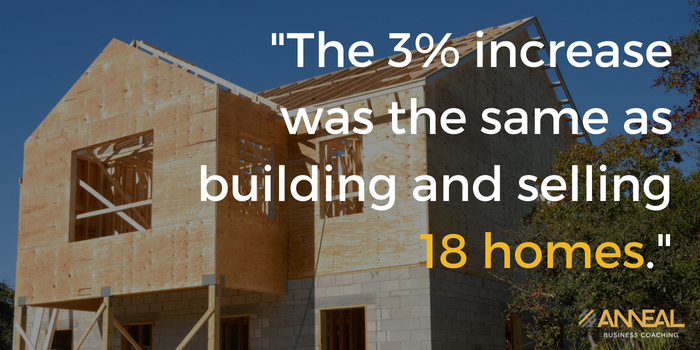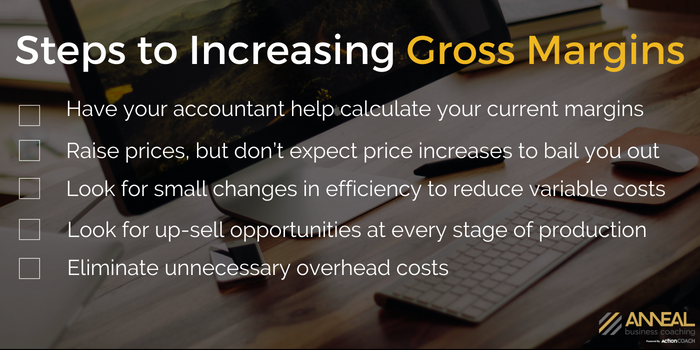Free houses sounds too good to be true, but have you noticed that some homebuilders thrive while others never seem to get ahead? I mean really ahead. The difference is that builders who thrive have figured out how to build houses for free and to pocket the gain as profit.
So how do they do it?
By understanding and controlling variable costs.
Variable costs are costs that go up and down with production – things like land, material, labor, interest and selling commissions. These costs go up when you build more houses and they go down when you build fewer.
Variable costs are different than fixed costs (overhead) that do not go up and down with production. Fixed costs include thing like office salaries, office rent, utilities and telephone.
“So what?” you may be thinking.
“Some costs go up and down, some stay the same. Cost is cost. What’s the big deal?”
The big deal is that, unlike changes to fixed costs, small changes to variable costs can have a dramatic impact on profit.
Save $1,000 on fixed costs, and you’ve saved $1,000. Save $1,000 on variable costs and you’ve saved $1,000 times the number of houses you build. Big difference.
Let me show you with a real-world example.
I know a home builder who builds about 60 homes per year and used to average 10% gross profit.
His 10% gross profit margins meant that for every dollar of sales, he spent about 90¢ on variable costs which left 10¢ as gross profit. His average house sold for about $300,000, so he earned a gross profit of $30,000 on an average house. Simple enough, right?

Through planning and persistent attention to process and detail, his team managed to increase margins from 10% to 13%. The 3% resulted in an increase of $9,000 gross profit per house.
Had it applied to his prior year’s total sales, the increase would have added $540,000 to his gross profit, the equivalent of building and selling an additional 18 homes at 10% margins.
Which would you rather do, build and sell 18 homes, or earn 3% higher gross margins? Better yet, how about doing both?
Three percent doesn’t sound like much, but when you think of it in terms of total dollars and free houses, it becomes clear how dramatic small changes in gross profit margins can be.
The builder did it by first calculating his margins accurately.
This is an essential first step because, as Edward Deming said, "You cannot manage what you do not measure."
“You cannot manage what you do not measure.”
Once you know your current margins, you will have a clear benchmark to improve upon.
It is important to get an accurate picture of your true margins. Through many conversations, I’ve found that many homebuilders believe their margins are larger than they really are. This is because many of their variable costs, such as land, interest and selling costs are misclassified as fixed costs.
Once the builder understood the huge impact of small changes and had calculated his margins, he and his team committed to finding ways to increase them.
One way to do that is to raise prices, but houses are priced by square foot and prices are capped by comps and appraisers. Therefore the team set out to reduce variable costs.
They selected build times (which affect interest cost), warranty work, change outs, wasted material, builder error, feature giveaways, closing cost concessions, and selling costs as variable costs that could be reduced. They tracked each cost and tied team bonuses to hitting targeted improvements. Finding small improvements in all of these areas is not difficult once you realize how much of a difference they make.
You can do it, starting right now.

The builder’s team also went to work finding ways to increase revenue without increasing prices per square foot. They noticed that by paying close attention to design, they could add 100 square feet to some houses for about $1,000. At market prices that additional 100 square feet would appraise for about $14,000 for a gross profit of $13,000.
They also found opportunities to up-sell customers. Up-sell opportunities come and go with various phases of construction. The team put in systems to assure every buyer was offered the opportunity to purchase upgrades at the appropriate time. As a result, they were able to sell upgrades such as exterior stonework, custom flooring, video and sound systems, weather packages, patio packages, irrigation for cash at high gross profit margins.
So, how many houses could you build for “free” by understanding your margins and paying close attention to your variable costs?
I assure you that the opportunities are there, but they will not be “home runs.” It’s the little things that matter most and accumulate into big results.
What if you don’t build houses?
There are similar opportunities in virtually every business – especially contracting businesses or any business that has inventory or significant variable costs. You might be able to build your house for free from the savings you find in your business.
If you found this information useful, stay informed by subscribing to my articles.
As always, I value your comments and and suggestions for future articles and welcome your emails to martin@annealbc.com.